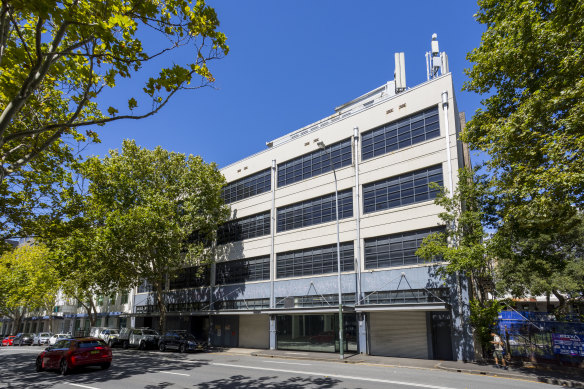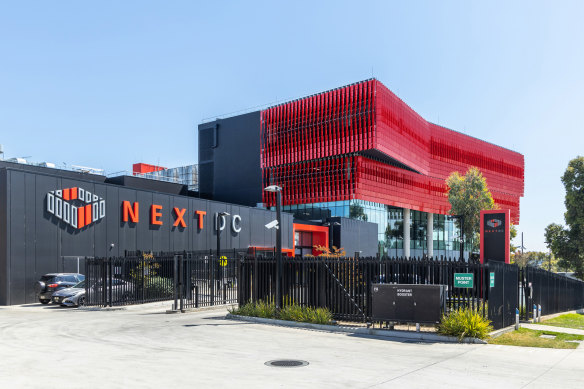This was published 2 years ago
Data-hungry apps spur rise in demand for data centres
Data centres, once considered a very alternative asset class that was overshadowed by demand for general warehouses, are now keenly sought by investors as strong occupier demand keeps vacancy rates at record lows.
The proliferation of these bespoke climate-controlled data centres has been fuelled by growth in data-hungry applications such as e-commerce, the introduction of new technologies like 5G and the impact of COVID-19 on remote working.
It is a multibillion-dollar market and any space is being eagerly snapped up from the listed investors to private businesses and small-to-medium super funds.

Fortius Funds Management has sold 549 Harris Street, Ultimo.Credit: © 2020 Mark Merton Photography
The Australian Data Centre Trends report from CBRE has revealed there is about 183,000 square metres of additional data centre space already under construction.
From an investment perspective, the CBRE’s report highlights that $US1.4 billion in data centres traded across the Asia Pacific region in 2022. Data centre storage demand has led to $3.8 billion worth of investment into Australia in just the past year. Globally, it is close to $13 billion and rising.
Demand for the asset class remains strong, with data centres ranked as the second most popular alternative sector for investment by respondents to CBRE’s 2023 Investor Intentions Survey.
Report author Bass Miller said a significant amount of new data centre supply will be added to
Australia’s major cities in the near term, with Victoria accounting for close to three-quarters of the total capacity under construction.
“New data centre capacity requirements are emerging from the rapid growth of cloud gaming and the metaverse, with AI also requiring more data, reliability, lower latency and proximity to end users,” Miller said,
Notable projects include the Microsoft Data Centre in Sydney’s Kemps Creek and Next DC’s M3 in Melbourne’s West Footscray. Other sales include a Sydney data centre at 549 Harris Street, Ultimo, which is leased to Optus, for $56 million by CBRE and JLL’s on behalf of Fortius Funds Management.
There is also the recently completed Amazon Data Centre at 42 Bluett Dr, Smeaton Grange, a 20,773 square metre facility built by Goodman.
Another deal was iseek’s purchase of data centre operator YourDC, which included two South Australian assets in Mitcham and Salisbury.
To attract more investors, the NSW Department of Planning updated its definition of data centres to temporarily allow more warehouses and data centres to be assessed as state significant development (SSD). These changes were made to provide a clearer and more certain planning pathway for warehouses and data centres.
The amendments change the way SSD thresholds for development of data centres are measured from capital investment value (CIV) to total power consumption. These changes will more accurately reflect the scale, complexity and potential impact of this type of development.
This will temporarily change the SSD threshold for data centres from $50 million CIV to 10 megawatts total power consumption, which roughly equates to a CIV of $40 million, for a two-year period, then to 15 megawatts after that.
The department has identified warehouses and data centres as types of development well-placed to support the state’s short-term economic recovery from the COVID-19 pandemic.
Stockland is leading the charge with its $2 billion M_Pak innovation and technology precinct at Macquarie Park where the first stage was “topped out” last week. It comprises three commercial buildings with shared amenity across the site covering 62,500 square metres, inclusive of the data centre.
In Melbourne, the only listed pure-play data centre group, NEXTDC, finalised a deal with HDR to design two of its colocation data centres that are set to house Australia’s largest and most comprehensive cloud ecosystem.

HDR has just completed the design and delivery of two NEXTDC colocation data centres.
Constructed by Kapitol Group, M3 Melbourne, a 100,000 square metre data centre in West Footscray, and M2 Melbourne, a 16,000 square metre data centre in Tullamarine, will collectively deliver 210 megawatts of critical IT infrastructure to enterprise and government in a climate of unprecedented digital innovation.
“The Australian digital economy is growing rapidly, accelerating the need for interconnected cloud services, sovereign secured, and sustainable solutions enabled by Tier IV certified facilities to assure business resilience,” said Craig Scroggie, NEXTDC chief executive.
“As a market leader, NEXTDC is responding to market demand by expanding our digital infrastructure platform.”
Sam Faigen, project leader at HDR added that utilising a data-driven design methodology, “we have succeeded in delivering two purpose-built facilities, using modular and adaptable solutions, that will accelerate industry growth.”
While the NSW data centre market remains the largest in Australia, CBRE’s report said there has been an increase in Victoria’s capacity, spurred by the state’s burgeoning technology sector.